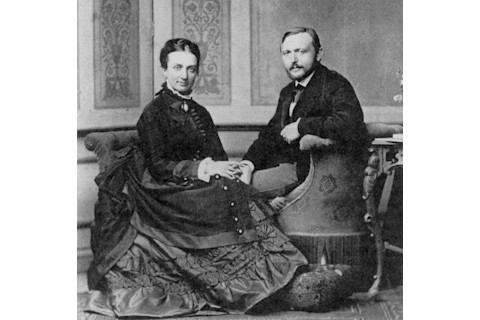By Jesse Bering

Richard von Krafft-Ebing and his wife Marie-Louise. The new Showtime series Masters of Sex is shining light on two remarkable figures in the history of sexology, William Masters and Virginia Johnson. Although most of us may not be aware of their colorful back-story, we have, at least, heard of “Masters and Johnson” before. Along with the famous Alfred Kinsey, they were iconic American figures in 20^th-century sex research, widely known for shirking the conservative conventions that kept our forebears in the closet of erotic ignorance. The history of sexology runs far deeper than a few charismatic figures, however. Their names may not be as familiar to us, but there were many other fascinating early sex researchers who left their own interesting legacies, and not always entirely positive ones at that. Some of these forgotten scholars were, like Masters and Johnson, angels of sexual healing; yet others were, quite frankly, bastards of bigotry. So without further ado, allow me to introduce you to five early sexologists that you’ve (probably) never heard of… at least, not like this. 1. Richard von Krafft-Ebing. Krafft-Ebing was an Austro-German psychiatrist who, back in 1886, wrote the book on abnormal sexuality. His encyclopedic tome on the subject, Psychopathia Sexualis, is an absorbing collection of case studies involving every imaginable type and category of deviant sexual desire. On the one hand, Krafft-Ebing set the stage for scholars to pathologize anyone whose erotic interests strayed from the heteronormative. Today’s clinical-forensic paradigm in which sexual paraphilias are usually interpreted can be traced back directly to him. On the other hand, Krafft-Ebing argued for a humane understanding of such individuals, seeing them as having no control over their own peculiar sexual lot in life. Some men, he reasoned, suffered from “satyriasis” (basically, nymphomania’s male counterpart) and should be forgiven their insatiable carnal appetites due to their mental and genetic defects leading to lustful excesses. The next time she catches you cheating, tell your wife or girlfriend that you were “born that way” (a satyr, that is), and let me know how that goes for you. I suspect you won’t have as much luck as Krafft-Ebing did when he managed to get rape charges entirely dismissed against some men by explaining the debilitating disease of satyriasis to the naïve judges. 2. Havelock Ellis. In 1897, this scholar from South London “borrowed” (plagiarized, some say) a bit of the posthumous work of a gay literary critic named John Addington Symonds and authored one of the earliest academic books on homosexuality. Titled Sexual Inversion—which reflected Ellis’s view of gays and lesbians as having an inside out, or “inverted,” pattern of erotic attraction—it was a sympathetic portrayal of the naturalness of same-sex desires. One of this sexologist’s most important contributions was his clarifying that homosexuality is a psychological orientation, not simply a random sex act or behavior involving the same sex. He didn’t personally believe that gays and lesbians were “perverts,” but he used this term to convey how religious moralists wrongly saw homosexuals and other “deviants” as deliberately “going against what is right,” since for hundreds of years before it ever connoted anything sexual, pervert was an epithet used for heretics and atheists. After Ellis, however, the term stuck crudely to homosexuals, used (almost unbelievably so) even among 1980s-era psychoanalysts as a technical term. Ellis wasn’t without his own unique sexual interests and was completely open about his worshiping of the “divine stream,” as he called it. He celebrated his “urophilia” (love of urine, or at least, people who are urinating) and saw no reason to hide it. “I may be regarded as a pioneer in the recognition of the beauty of the natural act in women when carried out in the erect attitude,” he wrote in his biography. “It was never to me vulgar, but, rather, an ideal interest, a part of the yet unrecognised loveliness of the world.” When a female friend forgot her purse at his house, he chided her in a letter: “I’ve no objection to your leaving liquid gold behind.” 3. Wilhelm Stekel. “Variatio delectat!” Stekel marveled in 1930 in the pages of his nightmarishly titled Sexual Aberrations. “How innumerable are the variations which Eros creates in order to make the monotonous simplicity of the natural sex organ interesting to the sexologist.” It was Stekel who coined the clinical term “paraphilia.” The first part of the word, para-, is Greek for “other” or “outside of,” and -philia translates roughly to “loving.” Some sexologists have quibbled over this choice, noting that “paralagnia” is a better fit, since we’re dealing with lust (-lagnia) not love. Stekel, the son of an illiterate Orthodox Jewish father, had trained briefly under Krafft-Ebing and was a former friend and apostle of Sigmund Freud’s. (He severed his ties with the latter after Freud blathered about Stekel’s own paraphilia to another psychoanalyst, Ernest Jones. Jones kept the secret, alas, and whatever floated Stekel’s boat went with him to his grave.) Stekel’s book is filled with carnival-style clinical studies of sexual deviance that make those described in his mentor’s Psychopathia Sexualis feel tame by comparison. He had a particular scholarly interest in amputee fetishism (“acrotomophilia”). The universe doesn’t have a sense of humor, but if it did, it would be black humor. Because to avoid having his own gangrenous foot removed due to diabetes, Stekel committed suicide at age 72, just a decade after he praised Eros’s cleverness. I suppose the prospect of being personally lusted after by a gerontophilic acrotomophile (one attracted to senior citizens with amputations) wasn’t quite so wondrous to him. 4. Kurt Freund. A prodigious theorist and researcher, Freund’s main claim to fame was his invention of the erection-detection machine (otherwise known as the “penile plethysmograph”). The “n” in his surname is important, since Freund was more interested in the, ahem, palpable hard facts of sexuality than he was in those fuzzy psychodynamics devised by a similarly named scholar from Vienna. In the early 1950s, Freund—a Holocaust survivor who’d somehow managed to avoid being deported to the concentration camps altogether during the Nazi occupation—was approached for help with a queer sort of problem by the Czechoslovakian army. Straight recruits were pretending to be gay to avoid their compulsory military service. It occurred to Freund that a soldier’s single dumb erection to a pretty naked lady, or the lack of one thereof, would betray his hidden sexual orientation. The specifics have gotten more complicated in the decades since his original erection-detection machine was patented, but the basics of the procedure have remained largely the same: A man sits down in a chair, his penis is connected to an erection gauge that can pick up very subtle changes in penile tumescence (it’s so sensitive that it can detect a blood-volume increase of less than one cubic centimeter, which most men wouldn’t even experience consciously), and he’s then shown randomized images of nude models representing distinct erotic categories. The scientist, meanwhile, measures what’s happening with the man’s own equipment as these photographs appear. A far cry from its initial purpose, Freund’s machine is today used mostly in forensic studies, ascertaining pedophilia in men arrested for sex crimes involving children. 5. Albert Ellis. No relation to Havelock, the psychologist Albert Ellis is best known as the founder of Cognitive Behavioral Therapy. But in 1964, his little-known book, Nymphomania: A Study of the Oversexed Woman, hit the shelves, and it was positively dripping with misogyny and homophobia. Coauthored by Edward Sagarin, Ellis reasoned that there are several different subspecies of nymphomaniacal female walking among us, introducing a few colorful specimens from his own clinic. Take the “Neurotic Type,” as illustrated by a young woman named “Gail.” “Several homosexual-nymphomaniacal matings have come to my attention in recent years…” Ellis begins his tale of Gail and her live-in gay BFF, “Burt.” A rather tetchy Ellis explains to us how Gail’s neurotic nymphomania was being enabled by Burt’s stubborn refusal to sleep with her, causing her to be as promiscuous as she wanted because she didn’t have to worry about Burt leaving her for a more attractive woman. Burt had zero sexual interest in Gail—he was, after all, gay—but what’s a little thing like patient consent with a zealous psychologist like Albert Ellis out to prove his case? “If she wanted to try,” Ellis tells us of his private conversations with Gail about her unrequited desires for Burt, “there was nothing to be lost in attempting to seduce Burt into heterosexuality … [so] the two of us devised a plan of attack on Burt’s heterosexual virginity.” Basically, Ellis instructed his eager client to weasel her hands into Burt’s pajama pants while he slept at night—technically, he prescribed a sexual assault. The whole dubious ploy, unsurprisingly, was a miserable failure, but rather than considering that conversion therapy might be ridiculous hogwash, Ellis blamed the lackluster outcome on Burt’s selfishness in acknowledging his “disturbance.” “He insisted he thoroughly enjoyed his homosexual activities,” Ellis grumbled about Burt, “and showed no inclination whatever to come for therapy.” Good for Burt.
Jesse Bering is the author of the new book Perv: The Sexual Deviant in All of Us. Find him on Twitter @jessebering.












